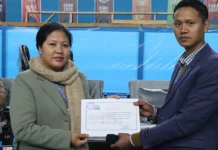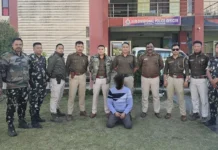[ Lopoli Melo ]
I had never been in a journey this far, especially alone. Shillong was the farthest I had gone to, and that was with teachers and friends. But this time it was different, in a special way and more intimidating.
I had to represent my university, Rajiv Gandhi University (RGU), and my state in the higher education institute (HEI) division in the Parliament for the ‘Parakram Diwas’, 2023 – a programme launched by the Parliamentary Research & Training Institute for Democracies (PRIDE) of the Lok Sabha secretariat.
I was selected to attend the paying of floral tribute to Netaji Subhas Chandra Bose on his 126th birth anniversary. But there was more to the event that intimidated me – an interaction session with the Prime Minister of India, Narendra Modi.
My journey started on 21 January. My brothers were so scared to send me alone that they accompanied me till the Guwahati airport. We reached the airport at around 7 am. From there, I had to do it all alone. The whole space felt glorious and intimidating when I first entered. But after four hours of waiting, the initial glory faded away. It all began to feel normal – just normal people, some shops, some good dæcopy;cor, some huge plants, and just normal people, like myself, waiting to leave this place for a new one.
Delhi was welcoming, and felt like home. I caught up with a few of my fellow participants from various other states towards the western court annex. It was where we were to stay for the next five days. The western court annex was all grandeur, meant specifically for the MPs, and I was fortunate enough to have had the opportunity to stay there.
Twenty-three January arrived just like any other normal day. But it was not normal, at least for us. We were instructed the previous day by the UGC’s PR Unit Section Officer Dwarka sir regarding how to dress, what not to take in, and all sorts of things. We had received our passes for the central hall of Parliament. It had a picture of Netaji and our names on it. There were strict security checks at the entrance. We were informed the previous day that the security was going to be thick and no bags or phones were allowed. There were students from various other divisions of PRIDE for the same programme – Nehru Yuva Kendra Sangathan, higher education division, school education division. Students from Delhi itself were also present.
I wore my traditional dress. My madam, Moyir Riba, RGU IDE assistant professor, was particular about my dress. She had told me that I was going to represent the whole state and asked me to be representative of the same. And so, for the Parakram Diwas, I wore my traditional Idu Mishmi attire and saved the Nyishi attire for the Republic Day, and brought with me a traditional Monpa bag.
On our arrival, we were taken first to the Parliament canteen and given our breakfast. Right after it, we were all escorted out to the garden for a photo session. Everyone was eager to get their photo taken with the Parliament in the background. The session was rather quick, despite the huge number of students present.
From there we hurried behind Miss Singh, who was the security officer. She was going to take us to the Lok Sabha and the Rajya Sabha. I think I had not had the realisation of where I was standing until I passed beneath the huge pillars and the thick stairs that was taking us upstairs towards the very same rooms where great heroes had taken their walk, taken in hopes for a sovereign India, drafted our Constitution, had discussions about the future of India. And here we are a free nation today and children from across the country brought in to witness history itself.
Parliament to me was just some pictures in books, news, and the internet. But it is here… very much present and very much alive. Imagination and emotions of patriotism of the uncountable leaders and fighters begin to consume one’s mind while in the building.
We were seated down in the public gallery while Ms Singh explained to us the setup and the colour significance of the Lok Sabha and of the Rajya Sabha.
In the central hall, Vijay Pal Guriyan sir, section officer, CU-CDN, later told us: “Not even MLAs are allowed in the central hall, and you are the lucky few to have received this opportunity.” It was true indeed. The atmosphere of the central hall was so consuming. The giant paintings of the freedom fighters seemed very much alive and continued to give images to the viewers about the lives they might have lived and their sacrifices. The beautiful massive dome underneath which was seated hundreds of students, wore Netaji’s cap to commemorate his 126th birth anniversary.
I was seated in the fourth column from the left, fourth seat from the first, exactly at the centre of the hall. It had been around 10 minutes or so when I spotted our External Affairs Minister S Jaishankar coming in from the front door. I gasped in disbelief; I could not hold back my excitement. Me and my friends started giggling out of happiness, hoping he would look towards us. And so he did, and gave us a good namaste, and with huge grins we did the same. One after another, our cabinet ministers began to appear. I also spotted our Lok Sabha Speaker Om Birla. Too many famous personalities in a single day!
Suddenly everyone stood up and there was a whole new excitement among the crowd, which made it obvious that PM was there. I leaned back and saw him walking towards us with his bodyguards surrounding him. My only thought was, Will I be able to talk to him? Or shake his hand?’ and I did not realise that I had already extended my hands towards him, and he shook my hands. They were so soft!
I was still processing everything and that’s when floral tribute to Netaji began and our national anthem was sung. After this, the PM began interacting with the students and fortunately, he walked up to us and he spoke to us – asked us where we were from and then proceeded towards other students on his way out and all his ministers followed behind him. Aviation Minister Jyotiraditya Scindia asked me, “How are you?” and “I am doing good, sir,” I replied, excitedly. And then Union Law Minister Kiren Rijiju asked me, “From Roing?” “No sir, I am from Anini,” I replied, much excitedly again.
All the dignitaries had left the hall and only the speaker sir remained to witness the programme. I regret that I did not get the opportunity to give a speech due to time limit, and there were already enough number of speakers who were selected on a random basis. However, the whole experience made it worthwhile. Students from across the country gave their speeches beautifully, and the programme came to an end with an address by the speaker sir. He spoke on how Netaji continues to inspire the youths and how his visions for the nation need to be carried forward by the youths.
The long-awaited day ended with an interaction programme between the students and the PM at his residence in 7, Lok Kalyan Marg, New Delhi. We were called in for high tea. The ambience of his residence was very soothing. Caterers waited on us; students were having their laughs, interacting casually with one another; there was a beautiful music in the background that was being played, probably practising for the Republic Day. Birds were chirping and flying around the residence. I spotted a peacock on a tree.
After 10 minutes or so, we were gathered to wait on the PM. We were instructed on how to present and what things were to be avoided. He arrived and we had a photo session and sat down for the interaction. It was a very casual interaction. There was an atmosphere of ease. He talked to us, cracked jokes, gave advice and stressed on being observant and to be aware of the moment and read more.
Over the next few days, we were taken around Delhi – to Rashtriya Swachhata Kendra, Jawaharlal Nehru Stadium, Pradhan Mantri Sangrahalaya – and given the opportunity to witness the Republic Day parade on Kartavya Path.
The very important thing that I learnt during the five-day programme was that the world is much bigger than we think it is. Visiting Delhi might not be a big-league talk, but it sure was for me. It has given me an insight to move out of the shell and realise that the rest of the country is in a race of progress and we need to catch up in that race.
I had never dreamt that I would be visiting all these important places; one might never get a chance even after a hundredth visit to Delhi that I had on my first. To meet the prime minister of our country is on another level. The indication here is that we need to see beyond what we have been looking at; the youths of Arunachal must grab the opportunity and work to be in the race with the rest of the world. The other world, seen from afar, seems unreachable and unachievable until we reach it and we find out that it is not impossible.
Programmes such as this truly brings out the essence of unity in diversity and broadens our perception. And thus, institutes really do need to expose students to such programmes. Investment in human resource is the best asset. (Lopoli Melo is an MA History student at RGU, Rono Hills)




